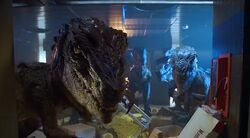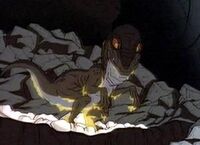The Juvenile Godzillas (幼若ゴジラ, Bebī Gojira?), nicknamed Baby Godzillas, were infant mutated marine iguana kaiju created by TriStar Pictures that first appeared in the 1998 American film, Godzilla.
Name
The juveniles Godzillas are never referred to by a specific name in their film appearance, only called "hatchlings" or "Godzilla's young." TriStar filed a trademark for the creatures under the name "Baby Godzilla™," and they even received their own copyright icon which appeared in merchandise for the film.
However, this trademark was cancelled by Toho and replaced with Toho's "BabyGodzilla™" trademark. Ultimately, all individual trademarks for the creatures were removed and absorbed under Godzilla's. The creatures' original official legal name is simply "baby Godzilla®."
A nickname, "Baby 'Zillas," is used in the script of the film's unmade sequel, Godzilla 2, however, due to the aforementioned falling out of the trademark, they have no official name anymore, outside "Godzilla".
Design
Appearance
The juveniles greatly resemble their father, but possess smaller proportions. The biggest difference between the two besides this is how lanky and slender the juveniles are, lacking the muscle mass and dorsal fins of their adult counterpart , as they more resemble a T-Rex
Roar
| Creature Audio |
The juvenile Godzillas had a roar akin to their parent, albeit at a higher pitch. Additionally, they produce a higher-pitched elephant roar and monster lizard sounds.
Origins
The juvenile Godzillas are the offspring of the original Godzilla that attacked New York in 1998. The monster asexually laid over 200 eggs in Madison Square Garden, which hatched into the juvenile Godzillas.
History
Godzilla

The juvenile Godzillas began to hatch shortly after Niko Tatopoulos and Philippe Roaché's team came upon Godzilla's nest in Madison Square Garden. The team had planned to destroy the eggs with explosives, but discovered there were far more eggs than they expected and they far outnumbered their supply of explosives. The hatchlings began to feed on the fish their parent had left in the nest, but their supply began to wane.
Smelling the scent of fish on Nick and the others, the juvenile Godzillas began to chase them across the arena. Philippe's fellow secret servicemen were devoured by the creatures, but he and the others reached a broadcast room that was normally used to air sporting events and barred themselves inside. Using the recording equipment, Audrey Timmonds broadcast a live report over the airwaves showing the juvenile Godzillas roaming through Madison Square Garden and warning of what would happen if they escaped. Colonel Hicks saw the broadcast and ordered three F-18 Hornets to deliver a missile strike on the building.
As the jets approached, the humans tried to escape while the infant Godzillas began to breach the arena. Running out of time, they ran towards the exit, pursued by countless juvenile Godzillas. Just as the humans escaped the building, missiles collided with Madison Square Garden, destroying it and killing all the juvenile creatures.
Just as the team thought their mission was accomplished, the adult Godzilla rose from under the streets and looked at the bodies of his slain young. Godzilla nudged the corpse of one of his young, only for it to lie motionless. Enraged, Godzilla began to chase the humans across New York.
Sometime later, a lone egg inside the ruined building hatched.
Godzilla: The Series

In the beginning of the series, after Godzilla's death, Niko Tatopoulos convinced Colonel Hicks to send a team into Madison Square Garden to ensure no other juveniles survived. Nick went in first, but fell into a cavern and was separated from the rest of the team. There, he encountered a surviving egg, which hatched into another juvenile Godzilla. Rather than attack Nick, the baby imprinted on him. Knowing the military was approaching, Nick scared the hatchling off with electrical wires, causing it to burrow out of the arena. After escaping, the hatchling rapidly developed into an adult Godzilla before it later returned to Nick, recognizing him as its adopted father. Since then, this new Godzilla assisted Nick and H.E.A.T. with battling other nuclear monsters across the globe.
Trivia
- The juveniles are often compared to the Velociraptors from Jurassic Park because of their design and behavior. Certain moments during the Madison Square Garden chase in the 1998 film are almost perfect replications of the Velociraptor stalking scenes in Jurassic Park, including a scene where one Godzilla gazes through a door and stalks the protagonists as they try to hide.
- According to Nick, they are "born pregnant" and the 200 young could quickly become 40,000 in a few years. This is similar to the "Tribbles" from Star Trek.
- The plot is reminiscent of the film Gremlins, with an original 'parent' creature that spawns a massive horde of offspring which then proceed to cause trouble and devour all sorts of food like candy and popcorn (as well as kill some humans), the horde being barricaded into a building that is then blown up, and finally the original creature being involved in a chase and ultimately killed.
- The juvenile Godzillas would have been featured in the unmade sequel to the 1998 film, with a pack of them being raised by the surviving Godzilla in the Australian outback. The infants would grow into adolescent Godzillas, only to be hunted down and killed by the U.S. military, save for one nicknamed "the Runt." The Runt would help his parent battle the Queen Bitch in Sydney, only to be apparently killed, and then later return to the film's conclusion.
